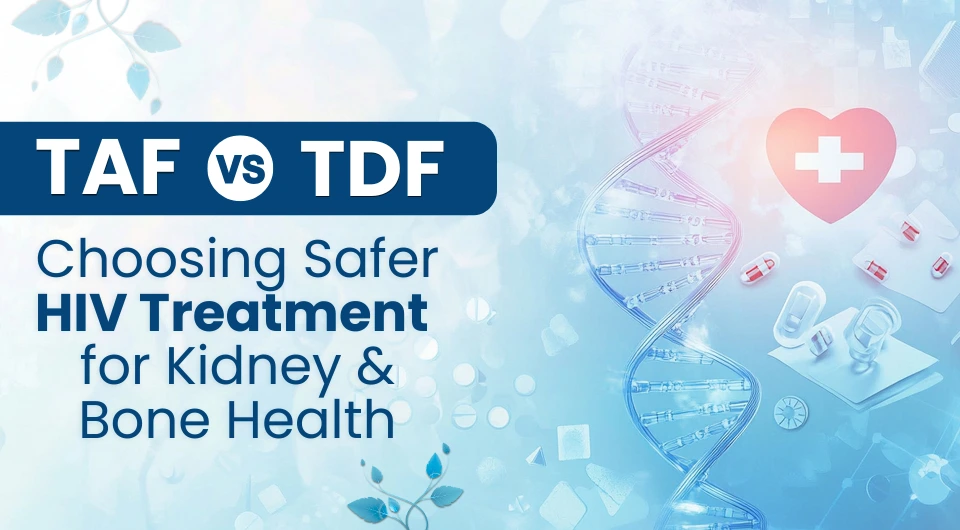When it comes to managing HIV, today’s treatments are more powerful and tolerable than ever before. People living with HIV can now look forward to long, healthy lives thanks in part to medications like TDF (Tenofovir Disoproxil Fumarate) and TAF (Tenofovir Alafenamide).
However, here’s the catch:-
“While both are highly effective, they don’t affect your kidneys and bones in the same way. So, how do you know which one is safer for long-term use?”
Let’s break it down in simple terms because a better understanding leads to better care.
Tenofovir: One Drug, Two Versions
Both TDF and TAF are forms of tenofovir, a cornerstone drug in HIV and hepatitis treatment. It is more often available in combination with other dosed medications in a single daily pill. However, even though they share the same goal, which is to stop the virus from multiplying, their actions within the body are quite different.
The table below will help clarify the key differences between TDF and TAF.
| Tenofovir Alafenamide Vs Tenofovir Disoproxil Fumarate | ||
| Key Difference | TDF | TAF |
| Where it activates | In the bloodstream | Inside your cells |
| How much tenofovir reaches the kidneys | High | Very low |
| Bone & kidney impact | More strain | Gentler and safer |
From the table, we can understand TAF as a smarter version of the drug, as it delivers the medicine right where it’s needed and avoids unnecessary stress on neighboring organs.
So, Which One Works Better?
Good news!
Both TDF and TAF are equally effective at controlling HIV. They help reduce the virus to undetectable levels and maintain this level.
But here’s where TAF really stands out: its side effect profile is much gentler, especially when it comes to kidney function and bone density.
A landmark study published in PubMed followed patients who switched from tenofovir disoproxil fumarate (TDF) to tenofovir alafenamide (TAF). Over 48 weeks, they maintained full viral suppression while also showing clear improvements in kidney and bone health.
Kidney Safety is Important in HIV Treatment
The kidneys work hard to filter out waste from the body, and some HIV drugs, like TDF, can be a bit tough on them over time. For people already dealing with kidney issues, diabetes, or high blood pressure, it is safe to say that this matters a lot.
What Can TDF Do to Kidneys?
- Decrease in eGFR (kidney function score)
- Protein in the urine (a sign of stress)
- In rare cases, Fanconi syndrome (a serious kidney damage)
What Makes TAF Safer?
TAF uses a lower dose to get the same effect. Because it delivers tenofovir directly into immune cells, there is less circulating in the bloodstream, resulting in far less reaching the kidneys.
Result? A much lower risk of kidney damage!
Now that we have explored the safety of TAF for the kidneys, it is time to delve into the understanding of TAF for bone health.
What About Bone Health?
Bones might not be the first thing that comes to mind with HIV medications, but they should be given the course of a long-term treatment.
TDF has been linked to bone thinning (osteopenia or osteoporosis), particularly in:
- Postmenopausal women
- Older adults
- Teenagers and young adults (developing bone mass)
After doctors’ prescriptions and a clear understanding of the individual’s prognosis, TAF tends to maintain stronger bones over time. The same study mentioned earlier showed better spine and hip bone density in people who switched from TDF to TAF.
Is TAF Always the Better Choice?
To answer it in the simplest way possible, the answer is not necessarily.
TAF is generally preferred for patients with kidney or bone concerns, and it’s becoming more common in first-line HIV treatment guidelines. But there are a few things to consider:
Potential Downsides of TAF:
- Slight weight gain (a few kilos in some people)
- Small rise in cholesterol levels
- Sometimes more expensive than TDF
For people with low risk factors and especially in settings where cost and access are major concerns, TDF still plays an important role in HIV treatment, but only after taking a doctor’s prescription.
When TAF Might Be the Better Fit

Given a series of random situations in which TAF may work well and why, read the table given below-
| Situation | Why TAF May Work Well |
| Already have kidney problems | TAF is easier on the kidneys |
| Worried about bone loss | It helps preserve bone density |
| Older or Postmenopausal | Age-related changes make TAF a safer pick |
| Living with both HIV and Hepatitis B | TAF is safe and effective for both |
| On multiple medications | TAF has fewer drug interactions |
HIV Treatment Should Be About the Long Run
Living with HIV today isn’t what it was two decades ago. People are not just surviving, but they’re thriving. That means treatment choices should reflect not only how well a medicine fights the virus, but also how gentle it is on the body over time.
Whether newly diagnosed or considering a switch in medications, it’s worth discussing the difference between TDF and TAF with the healthcare provider.
In Summary
- Both control HIV and HBV effectively.
- TAF is kinder to kidneys and bones.
- TAF is better suited for long-term use, particularly in individuals at high risk.
- Always weigh the cost, access, and individual health factors when making a choice.
Disclaimer: This blog/content is for informational purposes only and should not be considered medical advice. Always consult a healthcare professional before starting any treatment. The content is not intended to diagnose, treat, cure, or prevent any condition. Purchase medications only from reputable sources to ensure safety and authenticity.
FAQs
Q1. Is tenofovir alafenamide (TAF) safer than tenofovir disoproxil fumarate (TDF) for the kidneys?
Ans- Yes. TAF exposes the kidneys to less tenofovir, which reduces the risk of kidney damage, especially in people with pre-existing kidney concerns.
Q2. Is TAF better than TDF for kidney toxicity?
Ans- Absolutely. Clinical studies have shown that TAF users exhibit less protein in their urine, more stable kidney function, and fewer signs of toxicity.
Q3. What is the benefit of TAF over TDF in HIV treatment?
Ans- TAF offers the same powerful virus suppression as TDF, but with less impact on the kidneys and bones. It’s ideal for long-term use.
Q4. Does TDF cause bone loss?
Ans- Yes, especially in high-risk groups. Long-term TDF use can lead to a reduction in bone mineral density. TAF shows a safer profile for bone health.
Q5. Is TAF better than TDF for long-term use?
Ans- Yes. For many patients, especially those with health conditions or aging bodies, TAF is a more effective long-term choice.



